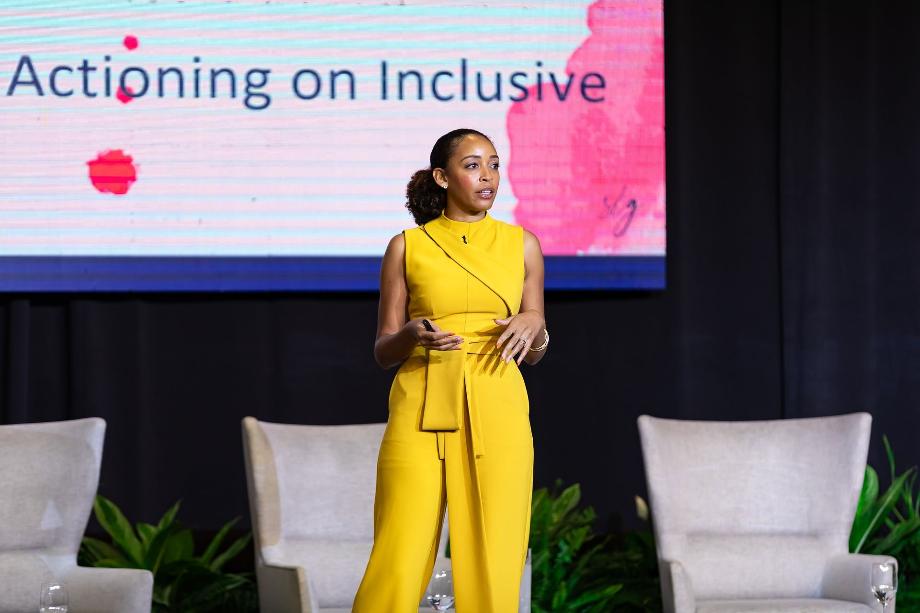Building An Inclusive Workplace Culture
By Kennedy Everett Maraj
Communications & Events Officer - AMCHAM T&T

LINKAGE Q4 (2022) - The Anniversary Issue
B uilding an inclusive workplace has many benefits: greater innovation, stronger brands, increased employee engagement, etc. Yet, the statistics continue to show a high degradation in employees' mental and physical health due to issues that are happening in the workplace. So, how can leaders get to the root of creating a space where people feel valued and have a sense of belonging?
In her feature address at AMCHAM T&T’s 26th Annual HSSE Conference at the Hyatt Regency in Port of Spain, Stephanie LeBlanc-Godfrey, Global Head of Inclusion for Women of Color at Google says that while building an inclusive culture is a critical component of reaching the true potential of any business, it also requires employers to be both business leaders and people leaders at the same time.
“The thing that I want us to really focus on no matter how we define success is merging the mindset of business and people skills, developing the roots of an inclusive culture, and then reflecting and acting on inclusive leadership,” LeBlanc-Godfrey says.
With a 20-year career as an engineer, a business leader, and a DEI practitioner, LeBlanc-Godfrey has centred her work on creating spaces for women of colour to thrive and progress in their careers while also influencing policies, programmes, and processes for over 50,000 parents and caregivers at Google.
PEOPLE-CENTERED MINDSET
LeBlanc-Godfrey says that building an inclusive culture starts with leaders focusing on people. This means having leaders actively merge their mindset with strengths of the business and people skills to create the commitment and motivation factors that allow people to do their best work. By adopting this people-centred mindset, companies should be concerned with:
1) Building relationships with colleagues. “It's not enough for us, especially in the space after Covid to be so transactional,” LeBlanc-Godfrey says. “We cannot say, ’Oh well, we're back to work and now let's just ignore the conversations and connectedness we've had over the last two years’. We need to ask how we develop that. How do we keep that going?” One way she recommends this can be done is to
2) Adopt a coaching mindset . This refers to reflecting and sharing the things you have done to get where you are and then providing the resources for your people to do the same, to help them reach their full potential.
Finally, focusing on people will require leaders to ensure that they are:
3) Aligning teammates towards a common goal. Competition in the workplace causes tension, which becomes a barrier to building collaboration among employees. Hence why LeBlanc-Godfrey says that facing business opportunities and challenges requires teammates to be aligned and working towards the same goals versus individual goals.
ROOTS OF INCLUSIVE CULTURE
Taking on these three steps means businesses must be committed to doing the work to change their environments so that employees can thrive. So, how do we create that environment? Ultimately, this comes down to the culture of the organisation.
“If the environment is unhealthy, we can't have success and thrive,” LeBlanc-Godfrey says. “We can't reach the true potential for a business. We can't reach the levels of success.”
Recognising this, LeBlanc-Godfrey says Google spearheaded a multi-year research study, beginning in 2016, in order to better understand what makes a perfect team. The project, named “Aristotle”, the man to whom the quote "The whole is greater than the sum of its parts" has been attributed, based on the belief that employees can do more when they are working together than alone. The findings identified “psychological safety” as the number one criterion for establishing a perfect team.
LeBlanc-Godfrey says that creating a perfect team and building an inclusive culture must have the presence of the f our components of psychological safety. These are:
1) Listen more, talk less.
“Leaders need to quiet their minds and listen to what their employees are saying but also listen to what they aren’t saying,” LeBlanc Godfrey says. “If you're just hearing ’Yes, yes, yes’, that doesn't mean that you're perfect and you got it all figured out. It means that your team members do not feel safe enough to have a positive dialogue.”
2) Praise generously .
Employees require praise that lets them know that they are doing something right and makes them feel good. LeBlanc-Godfrey warns that without praise, and the specificity around what employees are doing well, employees will feel unsure of how to operate and won’t know how to move forward.
3) Reframe negative feedback .
LeBlanc-Godfrey says that when sharing criticism, do so wisely. Leaders should try to reframe negative feedback by sharing their own experiences. “The point isn't to just tell someone ‘Hey, you did that wrong,’ but to say, ‘I actually made that mistake before’, or ‘Here's how it worked out for me’,” LeBlanc-Godfrey advises. She says that taking this approach will provide reflection to employees instead of making them feel like being talked down to. “That way, you are entering a conversation with folks and prepared them to have a respectful dialogue between two peers, between two equals, between two humans.”
4) Pay attention .
LeBlanc-Godfrey says that we must remember the humanity in each of us by paying attention to the little details that are impacting people from showing up. “There isn't a day that goes by that there isn't some little thing or even some really big thing that just weighs on our soul and sits in our spirit.” Because of these circumstances, LeBlanc-Godfrey says it’s important that leaders do check-ins with their employees, so that they can empathise and understand what their people are facing every day.
With these four aspects of psychological safety, LeBlanc-Godfrey warns not to do all of these things at once and become overwhelmed by them. “It's micro steps. It's intentionality. It's self-awareness around what we can do differently in each interaction that will just shift the perspective and shift the relationship in a positive way.”
REFLECT – ACTION ON THE THREE LAYERS OF INCLUSIVE LEADERSHIP
The next phase in creating an inclusive culture is around building inclusive leadership. This requires leaders to reflect on how they are modelling behaviours of authenticity, vulnerability and humanity. “Modelling that vulnerability lets the people around you know that it's okay to admit what you don't know. It's okay to then have a dialogue about what you're doing, where you are on your journey, and what you're doing to proceed forward.”
The next step is figuring out how to empower your people managers to bring empathy and psychologically safe spaces into the workplace. LeBlanc-Godfrey says there is an opportunity here for leaders who have the decision-making ability to create space to have these discussions with their people, but also to be able to provide resources to help them build better relationships with their staff.
Finally, changes to the system must be implemented through the organisation's three P’s (programmes, policies and processes) to create an equitable and inclusive workplace. LeBlanc-Godfrey advises leaders to really think through their existing the P’s in order to adjust the processes of engagement with employees to help them process and prepare for changes without having to call them out. “When you think differently and implement some of these strategies, you and your people can work towards an inclusive work culture,” says LeBlanc-Godfrey.
She advises that building an inclusive culture is the job of every person within the organisation. “It is not only your job, but it's also for you to reflect on and action on, for your team to reflect on and action on, and for the shift that we need to make in our systems in order to bring us to our true business potential.”
ABOUT THE AUTHOR
Kennedy Everett Maraj is the Communications & Events Officer at AMCHAM T&T